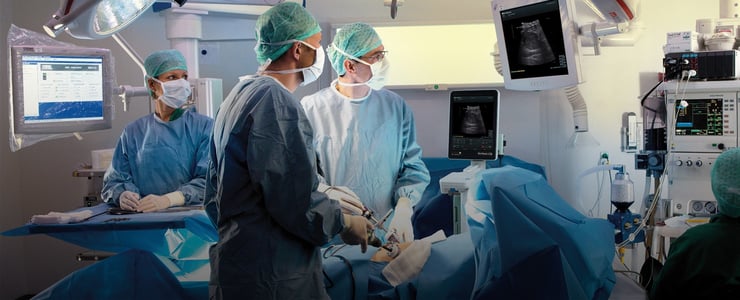
Professor Hongguang Wang is a hepatobiliary surgeon at the Chinese PLA General Hospital, in Beijing, China, one of the largest hospitals in the country. The facility has five sections in the hepatobiliary surgery department: hepatic surgery, biliary surgery, pancreatic surgery, minimally invasive surgery, and liver transplantation surgery. Dr. Wang is in charge of the minimally invasive surgery section. There, he performs laparoscopic hepatectomies, laparoscopic cholecystectomies, and laparoscopic common bile duct exploration.
About 12 years ago, Dr. Wang began using a BK Ultrasound system with a laparoscopic transducer to scan the biliary tract during laparoscopic cholecystectomies and found it very useful for biliary tract imaging. Since then, he’s gained valuable experience using ultrasound in other laparoscopic surgeries, such as laparoscopic hepatectomy and pancreatectomy. Dr. Wang finds laparoscopic ultrasound-guided thermal ablation an effective therapy for treating unresectable hepatic tumors, and safer and more precise than percutaneous ablation.
Several authors have described their experiences regarding the value of laparoscopic ultrasound-guided hepatic tumor ablation including:
• R. Santambrogio, University of Milan, “Laparoscopic Radiofrequency ablation (RFA) of Hepatocellular Carconima (HCC) proved to be a safe and effective technique, at least in terms of the short- and mid-term results. This technique may be indicated in selected cases of HCC when percutaneous RFA is very difficult or contraindicated.”1
• Seung Duk Lee, Seoul National University, “Laparoscopic RFA for hepatic malignancies proved to be a safe and effective treatment. Also, this procedure is indicated for lesions that are not amenable to percutaneous RFA or liver resection.” 2
• T. Herbold, the University of Cologne, “Laparoscopic RFA is a feasible and reliable therapy for unresectable HCCs in patients with cirrhosis. Laparoscopic RFA combines the advantages of minimally invasive procedures with the ability to carry out accurate intraoperative staging by laparoscopic ultrasound.” 3

Dr. Wang uses the BK Ultrasound 4-Way Laparoscopic transducer in his practice. He likes the design and the way its tip can bend in four directions which makes laparoscopic scanning easier. While he has used other laparoscopic transducers for laparoscopic ultrasound-guided ablation, he has found BK’s to be the best, with exceptional image quality. “You won’t miss any details of hidden lesions, even those smaller than 5 mm in diameter,” Dr. Wang said. “An important feature of BK’s transducer is that there is a dedicated puncture channel on the top. When doing the laparoscopic puncture, surgeons insert the needle through the puncture channel and use the guideline to help hit the target lesion.”
One of Dr. Wang’s cases includes a laparoscopic hepatic tumor ablation in which the patient suffered from HCC with severe hepatic cirrhosis, and the tumor was visible from the surface of the liver. Preoperative examination indicated that the patient could not tolerate hepatectomy. In addition, percutaneous ablation was contraindicated because the tumor was adjacent to the stomach. For this patient, laparoscopic ablation – safe, curative, and minimally invasive – was the ideal solution.
Using a laparoscopic transducer, Dr. Wang scanned the liver to help understand the spatial structure around the HCC lesion. After identifying the location of the lesion, he inserted an RFA electrode through the abdominal wall. He placed the tip of the electrode into the puncture channel on the top of the transducer. With the help of the puncture guideline, Dr. Wang and his team could easily target the lesion, with the RFA electrode clearly displayed on the screen.
This enabled them to determine whether the electrode was correctly inserted into the lesion. Next, they activated the radio frequency generator. Large amounts of bubbles appearing in the lesion area indicated that the lesion was being heated. After a few minutes, the echogenic signal of the lesion area became very weak, indicating that the lesion was destroyed. In order to do radical ablation, they inserted two more electrodes to ablate the lesion at the margins by placing the second electrode on the superior margin and the third electrode on the inferior margin. Finally, they scanned the liver again with the laparoscopic transducer. There was a hyperechoic ring zone about 1 cm in width around the lesion, with no color Doppler signal; indicating the safety margin of ablation.
Visit our surgery page to learn more about how our ultrasound systems can be used for intraoperative procedures. Click here to learn more about our new bk5000 surgical ultrasound system.
1 Santambrogio R, Opocher E, Montorsi M. Laparoscopic radiofrequency ablation of hepatocellular carcinoma: A critical review from the surgeon’s perspective. Journal of Ultrasound. 2008;11(1):1-7. doi:10.1016/j.jus.2007.12.003.
2 Lee SD, Han H-S, Cho JY, et al. Safety and efficacy of laparoscopic radiofrequency ablation for hepatic malignancies. Journal of the Korean Surgical Society. 2012;83(1):36-42. doi:10.4174/jkss.2012.83.1.36.
3 Langenbecks Arch Surg. 2013 Jan;398(1):47-53. doi: 10.1007/s00423-012-1018-5. Epub 2012 Oct 24.

